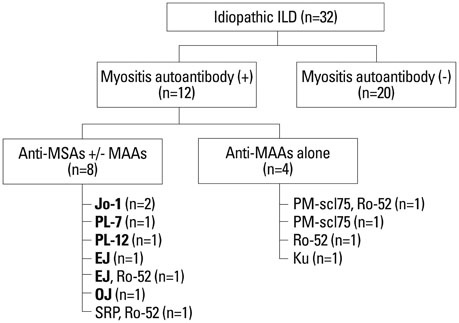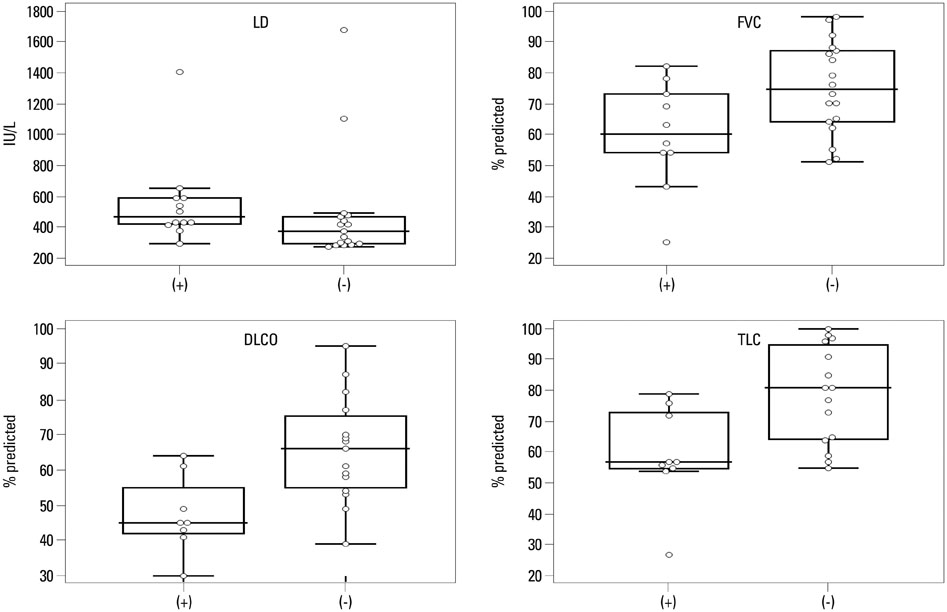Yonsei Med J.
2015 May;56(3):676-683. 10.3349/ymj.2015.56.3.676.
Significance of Myositis Autoantibody in Patients with Idiopathic Interstitial Lung Disease
- Affiliations
-
- 1Department of Laboratory Medicine and Genetics, Samsung Medical Center, Sungkyunkwan University School of Medicine, Seoul, Korea. eskang@skku.edu
- 2Department of Internal Medicine, Samsung Medical Center, Sungkyunkwan University School of Medicine, Seoul, Korea.
- 3Department of Pulmonary and Critical Care Medicine, Samsung Medical Center, Sungkyunkwan University School of Medicine, Seoul, Korea.
- KMID: 2450340
- DOI: http://doi.org/10.3349/ymj.2015.56.3.676
Abstract
- PURPOSE
Some patients with interstitial lung disease (ILD) related to connective tissue disease (CTD) have a delayed diagnosis of the underlying CTD when the ILD is categorized as idiopathic. In this study, we evaluated the frequency of myositis autoantibodies in patients diagnosed with idiopathic ILD and investigated the clinical significance stemming from the presence of the antibodies.
MATERIALS AND METHODS
A total 32 patients diagnosed with idiopathic ILD were enrolled in this study. We analyzed a panel of 11 myositis autoantibody specificities in the patients using a line blot immunoassay. Then, we divided them into myositis autoantibody-positive and -negative groups and compared the clinical features and laboratory data between the two groups.
RESULTS
Of the 32 idiopathic ILD patients, 12 patients had myositis autoantibodies encompassing 9 specificities, except for anti-Mi-2 and anti-PM-Scl 100 (12/32, 38%). Anti-synthetase autoantibodies including Jo-1, EJ, OJ, PL-7, and PL-12 were present in 7 patients (7/32, 22%). The group with myositis autoantibodies presented more frequently with the symptom of mechanic's hand and showed abnormal pulmonary function test results with low forced vital capacity, diffusing capacity for carbon monoxide, total lung capacity, and high lactate dehydrogenase values in blood when compared with the group without myositis antibodies.
CONCLUSION
We strongly suggest that patients undergo an evaluation of myositis autoantibodies, if they are diagnosed with idiopathic ILD in the presence of clinical characteristics including mechanic's hand, arthralgia, and autoantibodies which are insufficient to make a diagnosis of a specific CTD category.
MeSH Terms
Figure
Reference
-
1. Borchers AT, Chang C, Keen CL, Gershwin ME. Idiopathic pulmonary fibrosis-an epidemiological and pathological review. Clin Rev Allergy Immunol. 2011; 40:117–134.
Article2. Flaherty KR, Andrei AC, King TE Jr, Raghu G, Colby TV, Wells A, et al. Idiopathic interstitial pneumonia: do community and academic physicians agree on diagnosis? Am J Respir Crit Care Med. 2007; 175:1054–1060.3. Reynolds HY. Diagnostic and management strategies for diffuse interstitial lung disease. Chest. 1998; 113:192–202.
Article4. Park JH, Kim DS, Park IN, Jang SJ, Kitaichi M, Nicholson AG, et al. Prognosis of fibrotic interstitial pneumonia: idiopathic versus collagen vascular disease-related subtypes. Am J Respir Crit Care Med. 2007; 175:705–711.5. Strange C, Highland KB. Interstitial lung disease in the patient who has connective tissue disease. Clin Chest Med. 2004; 25:549–559.
Article6. Saketkoo LA, Ascherman DP, Cottin V, Christopher-Stine L, Danoff SK, Oddis CV. Interstitial Lung Disease in Idiopathic Inflammatory Myopathy. Curr Rheumatol Rev. 2010; 6:108–119.
Article7. Chen IJ, Jan Wu YJ, Lin CW, Fan KW, Luo SF, Ho HH, et al. Interstitial lung disease in polymyositis and dermatomyositis. Clin Rheumatol. 2009; 28:639–646.
Article8. Selva-O'Callaghan A, Labrador-Horrillo M, Muñoz-Gall X, Martínez-Gomez X, Majó-Masferrer J, Solans-Laque R, et al. Polymyositis/dermatomyositis-associated lung disease: analysis of a series of 81 patients. Lupus. 2005; 14:534–542.9. Fathi M, Lundberg IE. Interstitial lung disease in polymyositis and dermatomyositis. Curr Opin Rheumatol. 2005; 17:701–706.
Article10. Fathi M, Vikgren J, Boijsen M, Tylen U, Jorfeldt L, Tornling G, et al. Interstitial lung disease in polymyositis and dermatomyositis: longitudinal evaluation by pulmonary function and radiology. Arthritis Rheum. 2008; 59:677–685.
Article11. Targoff IN. Autoantibodies in polymyositis. Rheum Dis Clin North Am. 1992; 18:455–482.
Article12. Watanabe K, Handa T, Tanizawa K, Hosono Y, Taguchi Y, Noma S, et al. Detection of antisynthetase syndrome in patients with idiopathic interstitial pneumonias. Respir Med. 2011; 105:1238–1247.
Article13. Fathi M, Dastmalchi M, Rasmussen E, Lundberg IE, Tornling G. Interstitial lung disease, a common manifestation of newly diagnosed polymyositis and dermatomyositis. Ann Rheum Dis. 2004; 63:297–301.
Article14. Fischer A, West SG, Swigris JJ, Brown KK, du Bois RM. Connective tissue disease-associated interstitial lung disease: a call for clarification. Chest. 2010; 138:251–256.
Article15. Papiris SA, Kagouridis K, Bouros D. Serologic evaluation in idiopathic interstitial pneumonias. Curr Opin Pulm Med. 2012; 18:433–440.
Article16. Ghirardello A, Bendo R, Rampudda ME, Bassi N, Zampieri S, Doria A. Commercial blot assays in the diagnosis of systemic rheumatic diseases. Autoimmun Rev. 2009; 8:645–649.
Article17. Ghirardello A, Rampudda M, Ekholm L, Bassi N, Tarricone E, Zampieri S, et al. Diagnostic performance and validation of autoantibody testing in myositis by a commercial line blot assay. Rheumatology (Oxford). 2010; 49:2370–2374.
Article18. American Thoracic Society. European Respiratory Society. American Thoracic Society/European Respiratory Society International Multidisciplinary Consensus Classification of the Idiopathic Interstitial Pneumonias. This joint statement of the American Thoracic Society (ATS), and the European Respiratory Society (ERS) was adopted by the ATS board of directors, June 2001 and by the ERS Executive Committee, June 2001. Am J Respir Crit Care Med. 2002; 165:277–304.19. Selva-O'Callaghan A, Labrador-Horrillo M, Solans-Laque R, Simeon-Aznar CP, Martínez-Gómez X, Vilardell-Tarrés M. Myositis-specific and myositis-associated antibodies in a series of eighty-eight Mediterranean patients with idiopathic inflammatory myopathy. Arthritis Rheum. 2006; 55:791–798.20. Nakashima R, Imura Y, Hosono Y, Seto M, Murakami A, Watanabe K, et al. The multicenter study of a new assay for simultaneous detection of multiple anti-aminoacyl-tRNA synthetases in myositis and interstitial pneumonia. PLoS One. 2014; 9:e85062.
Article21. Fischer A, Swigris JJ, du Bois RM, Lynch DA, Downey GP, Cosgrove GP, et al. Anti-synthetase syndrome in ANA and anti-Jo-1 negative patients presenting with idiopathic interstitial pneumonia. Respir Med. 2009; 103:1719–1724.
Article22. Koenig M, Fritzler MJ, Targoff IN, Troyanov Y, Senécal JL. Heterogeneity of autoantibodies in 100 patients with autoimmune myositis: insights into clinical features and outcomes. Arthritis Res Ther. 2007; 9:R78.
Article23. Cruellas MG, Viana Vdos S, Levy-Neto M, Souza FH, Shinjo SK. Myositis-specific and myositis-associated autoantibody profiles and their clinical associations in a large series of patients with polymyositis and dermatomyositis. Clinics (Sao Paulo). 2013; 68:909–914.
Article24. Kinder BW, Collard HR, Koth L, Daikh DI, Wolters PJ, Elicker B, et al. Idiopathic nonspecific interstitial pneumonia: lung manifestation of undifferentiated connective tissue disease? Am J Respir Crit Care Med. 2007; 176:691–697.25. Plastiras SC, Soliotis FC, Vlachoyiannopoulos P, Tzelepis GE. Interstitial lung disease in a patient with antisynthetase syndrome and no myositis. Clin Rheumatol. 2007; 26:108–111.
Article26. Marie I, Josse S, Decaux O, Dominique S, Diot E, Landron C, et al. Comparison of long-term outcome between anti-Jo1- and anti-PL7/PL12 positive patients with antisynthetase syndrome. Autoimmun Rev. 2012; 11:739–745.
Article27. Kunimasa K, Arita M, Nakazawa T, Tanaka M, Tsubouchi K, Konishi S, et al. The clinical characteristics of two anti-OJ (anti-isoleucyl-tRNA synthetase) autoantibody-positive interstitial lung disease patients with polymyositis/dermatomyositis. Intern Med. 2012; 51:3405–3410.
Article28. Gunawardena H, Betteridge ZE, McHugh NJ. Myositis-specific autoantibodies: their clinical and pathogenic significance in disease expression. Rheumatology (Oxford). 2009; 48:607–612.
Article29. La Corte R, Lo Mo, Locaputo A, Dolzani F, Trotta F. In patients with antisynthetase syndrome the occurrence of anti-Ro/SSA antibodies causes a more severe interstitial lung disease. Autoimmunity. 2006; 39:249–253.
Article30. Ferreira JP, Almeida I, Marinho A, Cerveira C, Vasconcelos C. Anti-ro52 antibodies and interstitial lung disease in connective tissue diseases excluding scleroderma. ISRN Rheumatol. 2012; 2012:415272.
Article
- Full Text Links
- Actions
-
Cited
- CITED
-
- Close
- Share
- Similar articles
-
- A Case of Dermatomyositis with Acute Interstitial Pneumonitis Manifested as Antisynthetase Syndrome
- Idiopathic Interstitial Pneumonias: Radiologic Findings
- Interstitial Lung Diseases: Respiratory Review of 2013
- A Case of Rituximab Treatment for Interstitial Lung Disease in a Patient with Antisynthetase Syndrome
- Reported Lung Adenocarcinoma with Idiopathic Pulmonary Fibrosis after Open Lung Biopsy



